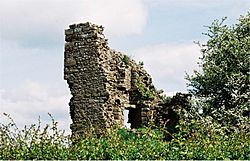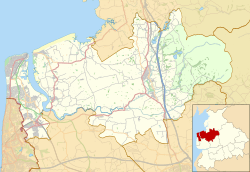Greenhalgh Castle facts for kids
Quick facts for kids Greenhalgh Castle |
|
|---|---|
| Near Garstang in England | |
 |
|
|
Location in the Borough of Wyre
|
|
| Coordinates | 53°53′59″N 2°45′42″W / 53.8998°N 2.7618°W |
| Type | Castle |
| Site information | |
| Open to the public |
No |
| Condition | Ruined |
| Site history | |
| Built | 1490 |
| Built by | Thomas Stanley |
Greenhalgh Castle is a castle that is now in ruins. You can find it near the town of Garstang in Lancashire, England. It was once an important building, but today only parts of it remain.
Contents
Building Greenhalgh Castle
Who Built Greenhalgh Castle?
Thomas Stanley, 1st Earl of Derby, ordered the castle to be built in 1490. He wanted a strong defence for his lands around Garstang. It is said that his stepson, Henry Tudor, gave him the land. This was a thank-you gift for Stanley's help. Stanley helped Henry defeat Richard III at the Battle of Bosworth. This battle was a very important event in English history.
What Did the Castle Look Like?
In the 1500s, a writer named John Leland called it a "pretty castle." It was built on a small raised area, about 35 metres (38 yards) square. The castle itself was rectangular. It had four square towers at each corner, each about 24 metres (26 yards) square. The castle was made from rough stones and sandstone. The main entrance was on the east side, which was higher ground. There was likely a moat (a ditch filled with water) around the lower parts of the castle.
Greenhalgh Castle During Wartime
The English Civil War
Greenhalgh Castle played a big role in the English Civil War. This war was fought between those who supported King Charles I (called Royalists) and those who supported Parliament (called Parliamentarians). In 1644, James Stanley, 7th Earl of Derby, used the castle to support King Charles I.
The Siege of Greenhalgh Castle
Greenhalgh Castle was one of the last places in Lancashire held by the Royalists. It faced a tough attack from Oliver Cromwell's forces. This attack, called a siege, lasted for many months in 1644 and 1645. Colonel Dodding and Major Joseph Rigbie led the Parliamentarian forces. The soldiers inside Greenhalgh Castle finally gave up in May 1645. They were allowed to go home safely.
Why is the Castle Ruined?
After the war, parts of the castle were deliberately destroyed. This was done to make sure it could not be used for fighting again. Over time, the castle fell apart even more. Today, only the bottom part of one of the original four towers remains. Many local farmhouses, like the nearby Castle Farm, used stones from the castle ruins to build their own homes. In 1772, a writer named Thomas Pennant described it as the "poor remains of Greenhaugh Castle."
Images for kids



